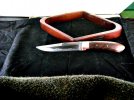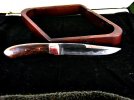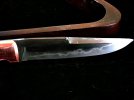- Joined
- Dec 18, 2008
- Messages
- 760
I have been off of the forum for a couple of months. I haven't really made many knives lately due to personal stuff. I made a couple to get back into the swing before I try some full-sized stuff. Plus, I wanted to get my heat treating and polishing down with subtle pattern welded stuff that has a visible grain and hamon. So, here are some of the test pieces made along the way. Two of these, the cable one and the one with ironwood scales and a vivid hamon, I did not finish fully. They were just "test" pieces to look at the heat treatment and blade grain with eips cable for the little blade and 400 layers of random low manganese 1075 and w2 for the bigger blade with ironwood scales. I like to use this full-tang construction on things I am putting together fast and for fun. These will all be gifts to family and friends, and they make really good users.
The blade that is is fully finished, it is just w2, no pattern welding. It has texture on the spine from hammering left on, but is fully finished. The apparent waves in the grind line are due to the hammer texture, not to me losing my vision or something.
thanks for looking. Let me know what you think about the approach of subtle pattern welding with a hamon to imitate traditional techniques. These are all about me learning things so I can imitate traditional knife and swordmaking (especially Chinese and Eurasian, at least that's my plan now).
take care,
Kevin
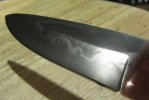

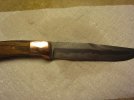
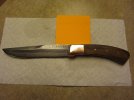 View attachment 233962
View attachment 233962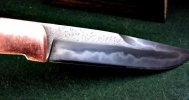
The blade that is is fully finished, it is just w2, no pattern welding. It has texture on the spine from hammering left on, but is fully finished. The apparent waves in the grind line are due to the hammer texture, not to me losing my vision or something.
thanks for looking. Let me know what you think about the approach of subtle pattern welding with a hamon to imitate traditional techniques. These are all about me learning things so I can imitate traditional knife and swordmaking (especially Chinese and Eurasian, at least that's my plan now).
take care,
Kevin



 View attachment 233962
View attachment 233962
Last edited:


